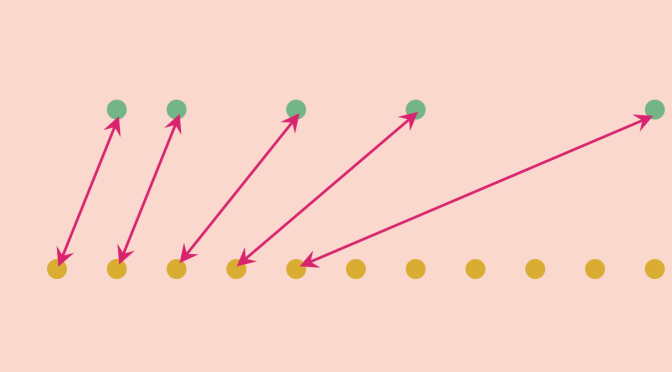In mathematics, the cardinality of a set is a measure of the “number of elements of the set”. We denote by \(|A|\) the cardinality of the set \(A\). We say that \(A\) and \(B\) have the same cardinality if there exists a bijection from \(A\) onto \(B\). Such sets said to be equinumerous.
The finite sets satisfy the property that if \(A \subset B\) and \(A\) and \(B\) have the same cardinality then \(A=B\). For example take \(A=\{2,5,42\}\). If \(A \subset B\) and \(B\) has more elements than \(A\), a bijection \(f\) from \(A\) to \(B\) cannot exist as an element in \(B \setminus \{f(2),f(5),f(42)\}\) won’t have an inverse image under \(f\).
This becomes false for infinite sets. Let’s give some examples.
Proper subsets of \(\mathbb N\) equinumerous to \(\mathbb N\)
The set \(A\) of the positive even integers is strictly included in \(\mathbb N\): there exist odd positive integers! However, \(A\) is equinumerous to \(\mathbb N\). The map \(f : n \to 2n\) is a bijection from \(A\) onto \(\mathbb N\).
For our second example, consider the set \(\mathbb P\) of prime numbers. We recall that \(\mathbb P\) is infinite. The proof is quite simple by contradiction. Suppose that there is only a finite number \(\{p_1, \dots, p_n\}\) of prime numbers and consider the number \(N = p_1 p_2 \cdots p_n + 1\). As a consequence of the fundamental theorem of arithmetic, a prime \(q\) divides \(N\). However \(q \notin \{p_1, \dots, p_n\}\) as this would imply \(q\) divides \(1\). From there, we can define by induction a bijection from \(\mathbb N\) onto \(\mathbb P\) by defining \[f(n)=\begin{cases}
2 & \text{for } n=1\\
\min (\mathbb P \setminus \{p_1, \dots, p_n\}) & \text{else }
\end{cases}\]
Proper subsets of \(\mathbb R\) equinumerous to \(\mathbb R\)
Consider the map \[\begin{array}{l|rcl}
\tan : & (-\frac{\pi}{2}, \frac{\pi}{2}) & \longrightarrow & \mathbb R\\
& x & \longmapsto & \tan x \end{array}\] \(\tan\) is continuous, strictly increasing and \(\lim\limits_{x \to \pm \frac{\pi}{2}} = \pm \infty\). Hence, \(\tan\) is a bijection from the proper subset \((-\frac{\pi}{2}, \frac{\pi}{2})\) of \(\mathbb R\) onto \(\mathbb R\).
Let’s consider a more amusing case! And take \[\begin{array}{l|rcl}
h : & \mathbb R & \longrightarrow & \mathbb R \setminus \{n \pi \ | n \in \mathbb N\}\\
& n \pi, \ n \in \mathbb N & \longmapsto & 2n+1\\
& n \in \mathbb N & \longmapsto & 2n\\
& x & \longmapsto & x \text{ else}
\end{array}\] One can verify that \(h\) is a bijection. However the image of \(\mathbb R\) under \(h\) excludes all reals from the set \(\{n \pi \ | n \in \mathbb N\}\).
Can we follow on this path and find a bijection from \(\mathbb R\) onto the rational numbers? The answer is negative and I will come back later on on this question.


One thought on “Counterexamples around cardinality (part 1)”